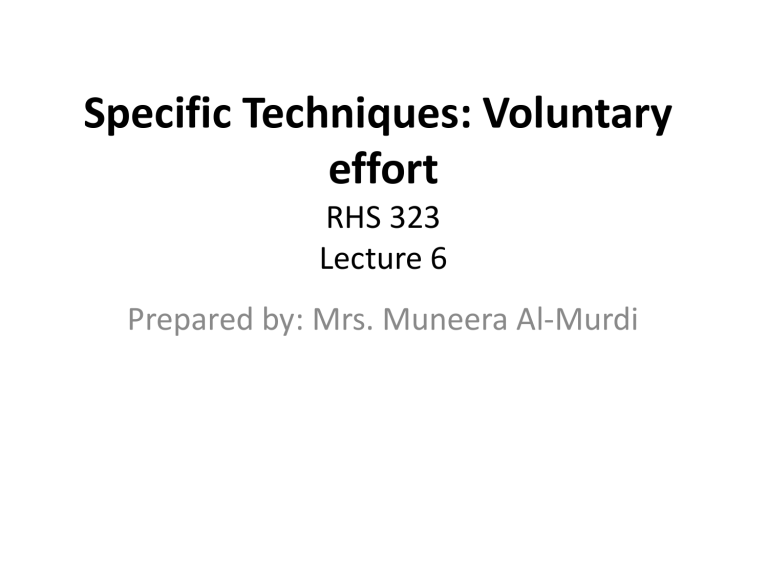Specific Techniques: Voluntary effort RHS 323 Lecture 6

Specific Techniques: Voluntary effort
RHS 323
Lecture 6
Prepared by: Mrs. Muneera Al-Murdi
Directed to agonist
Repeated Contraction (RC):
Repetition of activity is necessary to the learning process and to the development of strength and endurance.
This repetition is obtained through a technique of emphasis, repeated contraction.
Directed to agonist
Repeated Contraction (RC):
To emphasize a weak pattern, motion is repeated until fatigue is evident, fatigue will be delayed if the stretch reflex is coupled with the patient’s voluntary effort.
Directed to agonist
Repeated Contraction (RC):
The less advanced form of repeated contraction involves only isotonic contractions stimulated by use of stretch reflex as the patient attempts the movements.
Repeated isotonic contractions induced by stretch reflex may be the only choice when a patient
cannot move voluntary, or the patient is unable to perform a hold with isometric contraction.
Directed to agonist
Repeated Contraction (RC):
The more advanced form of repeated contraction uses both isotonic and isometric contractions.
As the patient’s strength and endurance improves, performance of hold contraction may be possible.
Directed to agonist
Hold- Relax- Active Motion (HRA)
HRA is indicated if a patient has marked weakness in the lengthened range of pattern, marked lack of endurance, or marked imbalance in the antagonistic pattern.
Directed to agonist
Hold- Relax- Active Motion (HRA)
HRA is a technique of emphasis that provides repetition of isotonic contraction without sustained effort.
Directed to agonist
Hold- Relax- Active Motion (HRA)
-Isometric contraction in the shortened range, hold has been secured and resisted strongly then the patient instructed to be relaxed his hold- the therapist immediately and quickly move the part passively into the lengthened range and instruct the patient to pull.
Directed to agonist
Hold- Relax- Active Motion (HRA)
HRA is contraindicated if full range of passive motion and resisted motion are painful.
Directed to agonist
Correction of imbalances:
In pattern of facilitation imbalances may be present with relation to the major muscle components of a specific pivot.
may also exist between antagonistic patterns in relation to various pivots of action.
Directed to agonist
Hyperactive reflexes
Imbalances may exist between antagonistic reflexes.
For example, if extensor spasticity is sever that it may prevents voluntary flexing his lower extremity.
Directed to agonist
Pivots for emphasis
In facilitation techniques, the development of muscle power and correction of imbalances proceeds from proximal to distal.
-neck and trunk
-proximal pivots of the extremities
-distal pivots of the extremities
Directed to agonist
Rhythmic initiation (RI)
Is used to improve the ability to initiate movements. Is helpful to those patients who lack the ability to initiate movement (ex.
Parkinsonian)
This technique involves voluntary relaxation, passive movement, and repeated isotonic contractions of the agonist pattern.
Reversal of antagonists
There are four reversal techniques that may be used primarily for stimulation, buildup in power, and gain range of motion.
1- Slow Reversal (SR)
2- Slow Reversal-Hold(RSH)
3-Rhytmic Stabilization (RS)
4- Quick Reversal (QR)
Reversal of antagonists
- SR involves an isotonic contraction of the agonist followed by isotonic contraction of the agonist.
- SRH involves isotonic followed by isometric contraction of the antagonist, followed by the same sequence of contraction of the agonist.
- RS involves simultaneous isometric contraction of antagonists.
- QR involves quick reversal, rapidly alternating isotonic contractions of antagonists.
Reversal of antagonists
Relaxation
Contract-Relax (CR)
Hold-Relax (HR)
Slow Reversal-Hold-Relax (SRHR)
Relaxation
Contract-Relax (CR):
Involves an isotonic contraction of the antagonist, allowing range of motion in rotation against maximal resistance but no rang of other components, followed by a period of relaxation
Relaxation
Hold-Relax (HR):
This technique performed as the same sequence in CR since an isometric contraction is involved.
Relaxation
Slow Reversal-Hold-Relax (SRHR):
Involves isotonic contraction of antagonist followed by isometric contraction of the antagonist pattern followed by a brief period of voluntary relaxation, followed by isotonic contraction of the agonist pattern.
Relaxation
Rhythmic Rotation (RRO):
The patient’s voluntary effort is enlisted. When voluntary control is present, the patient may perform actively. When voluntary control is absent, the therapist performs rhythmic rotation passively.





